One can see it throughout “Waterloo” – the closing episode of Mad Men, Season 7.1 – this era, these characters, Matthew Weiner seeks to bring them all back to circle. Most things being cyclical in nature (as Jon Hamm and several Mad Men promos have recently alluded to them being), with significant weight being afforded to the notion Weiner’s team is going to leave the lot of Mad Men‘s characters better off than they began, one can begin to see the forest for its trees. And so here now, based on minor clues and insight, is what one can expect to see by way of 10 primary characters during Mad Men‘s final run:
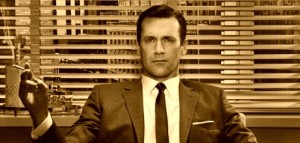 Don Draper. The story of Don Draper reads like a new-age Gatsby, perhaps a more realistic one, at that, with the difference being Don Draper has already realized his nadir, and begun to claw his way back. Don is a master of reinvention, and this is critical, as rebirth signaled Don’s emergence on the scene and it’ll likely play a role throughout his bow.
Don Draper. The story of Don Draper reads like a new-age Gatsby, perhaps a more realistic one, at that, with the difference being Don Draper has already realized his nadir, and begun to claw his way back. Don is a master of reinvention, and this is critical, as rebirth signaled Don’s emergence on the scene and it’ll likely play a role throughout his bow.
As the age of the antihero begins to exceed its critical mass, showrunners find themselves hard-pressed to put a harrowing end to primary characters. Tony Soprano is presumably dead (regardless of how some asshole misinterprets David Chase), Omar Little is dead, Walter White is dead, Nucky Thompson is dead, and so is Jackson Teller. Fortunately, Matthew Weiner seems more interested in salvation. In a story with the setting of Mad Men, it wouldn’t make much sense for Don Draper to simply kill himself. Lane Pryce and Adam Whitman have already done that, and the chances of seeing three significant characters committing suicide in one critically-acclaimed series seem unlikely. Forget about the opening credits. If you believe any television exec secretive enough to avoid releasing new footage prior to every upcoming season is simultaneously stupid enough to tip his hand during the opening seconds of every episode … well, that might be a poor assumption, at best. The only way a ritual suicide would make any sense would be if Don somehow went out as a martyr, bequeathing a great deal of his fortune to Anna Draper’s niece, or, more to the point, that niece’s child. The idea of Don providing a chance for the indirect descendant of a man whose identity he stole – a child born into this world under similar circumstances, no less – would appear to thread the needle almost seamlessly. Yet the thing is, there really is no need for Don to die in order for this to happen. Instead, look for Don to make a permanent move out west, providing full support for Anna Draper’s niece’s child. Don may even raise the child as his own, depending on its status. Look for Don to abandon advertising, to reinvent himself in California. Given the time period – and the setting – one might even imagine Don as securing a foothold in the computer industry. Silicon Valley represented a goldmine during the seventies, and the idea of Don getting in on the ground floor would bridge both eras like a lattice. The long-shot? Don becoming some sort of pitchman inside the Hollywood machine. Would he be fantastic? Sure. But the publicity arm of Hollywood seems like an unlikely destination for any man who’s vowed to leave that sort
of thing behind.
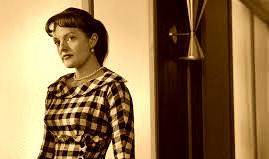 Peggy Olson. One of the more fascinating aspects of a long-running serial involves going back after the curtain falls and re-watching the original pilot. Breaking Bad is almost heartbreaking in this manner. Along those lines, no showrunner seems more aware of what each character was initially meant to represent than Matthew Weiner. Less than 15 minutes into the Mad Men pilot, Peggy Olson is introduced as “Don’s girl,” one in a revolving carousel of secretaries handling his desk. Peggy arrives appearing homely, green and unassuming, yet deceivingly intelligent. Looking back – even without the benefit of Season 7.2 – it’s clear that Peggy’s character was always meant to be a symbol of empowerment. The only way to properly seal Peggy’s ascent is by placing her in the same position Don originally inhabited back in 1960. Look for Peggy to represent the creative force in Jim Cutler’s advertising agency of the future. She may be a partner (albeit just barely), and she may be on the cusp. Mad Men’s writing team has been teasing this for the better part of a decade, most demonstrably when Peggy eases into Don’s chair toward the end of Season Six, caught in the pose of an iconic silhouette from the show’s opening credits.
Peggy Olson. One of the more fascinating aspects of a long-running serial involves going back after the curtain falls and re-watching the original pilot. Breaking Bad is almost heartbreaking in this manner. Along those lines, no showrunner seems more aware of what each character was initially meant to represent than Matthew Weiner. Less than 15 minutes into the Mad Men pilot, Peggy Olson is introduced as “Don’s girl,” one in a revolving carousel of secretaries handling his desk. Peggy arrives appearing homely, green and unassuming, yet deceivingly intelligent. Looking back – even without the benefit of Season 7.2 – it’s clear that Peggy’s character was always meant to be a symbol of empowerment. The only way to properly seal Peggy’s ascent is by placing her in the same position Don originally inhabited back in 1960. Look for Peggy to represent the creative force in Jim Cutler’s advertising agency of the future. She may be a partner (albeit just barely), and she may be on the cusp. Mad Men’s writing team has been teasing this for the better part of a decade, most demonstrably when Peggy eases into Don’s chair toward the end of Season Six, caught in the pose of an iconic silhouette from the show’s opening credits.
The most recent episode of Mad Men included a scene during which Peggy walks into her apartment, entering into an exchange with a contractor. This contractor’s name is Nick, and at one point Nick hands Peggy his number, saying, “In case you have any odd jobs, too small for Kaz.” The odds are long against this contractor disappearing. In fact, a guy like Nick makes perfect sense for Peggy Olson (i.e., a young Don Draper married the cotillion queen; why not have Peggy get it on with a strapping Dan?). Peggy’s got an apartment opening up and she may be in need of a super. To have Peggy Olson end up in the same place Don began, well, that would be some symmetry, to say the least.
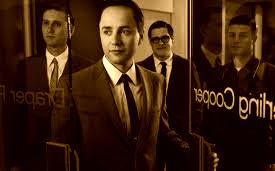 Pete Campbell. In terms of arc, Roger Sterling represents the same to Peter Campbell as Donald Draper does to Peggy. Though the show initially harped on the surrogate relationship between Don and Pete (with Pete perennially pushing for – and eventually earning – Don’s approval), Pete’s ongoing pissing match with Roger has taken center stage. Pete retains that blue-blood air, a family crest that got his foot inside the door. Yet at the age of 36, one can see him maturing into partner … an ill-begotten brat who’s earned his keep along the way. In Jim Cutler’s advertising agency of the future, expect Pete Campbell’s name to be the second on the door.
Pete Campbell. In terms of arc, Roger Sterling represents the same to Peter Campbell as Donald Draper does to Peggy. Though the show initially harped on the surrogate relationship between Don and Pete (with Pete perennially pushing for – and eventually earning – Don’s approval), Pete’s ongoing pissing match with Roger has taken center stage. Pete retains that blue-blood air, a family crest that got his foot inside the door. Yet at the age of 36, one can see him maturing into partner … an ill-begotten brat who’s earned his keep along the way. In Jim Cutler’s advertising agency of the future, expect Pete Campbell’s name to be the second on the door.
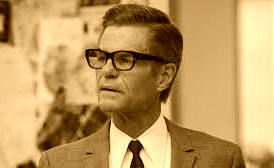 Jim Cutler. One of the last things Bert Cooper said to Roger Sterling – or anyone, for that matter – was that Jim Cutler has a vision. For six-and-a-half seasons, Bert Cooper represented the most whimsical of Mad Men‘s characters, stunningly unaware of his own eccentricity. Cooper was the sage, buried deep inside his vault, popping out only occasionally to dictate proper course. Those glasses, the elitism, an outward lack of physical emotion … Jim Cutler is slowly turning into Bertram Cooper. In the ad agency of the future, Cutler will become the figurehead Bertram Cooper always was, steering the ship when it prevails on him to do so.
Jim Cutler. One of the last things Bert Cooper said to Roger Sterling – or anyone, for that matter – was that Jim Cutler has a vision. For six-and-a-half seasons, Bert Cooper represented the most whimsical of Mad Men‘s characters, stunningly unaware of his own eccentricity. Cooper was the sage, buried deep inside his vault, popping out only occasionally to dictate proper course. Those glasses, the elitism, an outward lack of physical emotion … Jim Cutler is slowly turning into Bertram Cooper. In the ad agency of the future, Cutler will become the figurehead Bertram Cooper always was, steering the ship when it prevails on him to do so.
 Roger Sterling. What does one do after he realizes money only represents one-third of the equation? If one is Roger Sterling, he winds up embarking on a vision quest in his 50s, drifting off in the hopes of rediscovering what’s lost. Expect Roger to take the money and run, spurred into action by the departure of Don Draper. Men like Roger Sterling prey upon prestige in the same way men like Cutler prey upon the investment. With little to gain and nothing to earn, you can expect Roger Sterling to bow out fiscally, and alone.
Roger Sterling. What does one do after he realizes money only represents one-third of the equation? If one is Roger Sterling, he winds up embarking on a vision quest in his 50s, drifting off in the hopes of rediscovering what’s lost. Expect Roger to take the money and run, spurred into action by the departure of Don Draper. Men like Roger Sterling prey upon prestige in the same way men like Cutler prey upon the investment. With little to gain and nothing to earn, you can expect Roger Sterling to bow out fiscally, and alone.
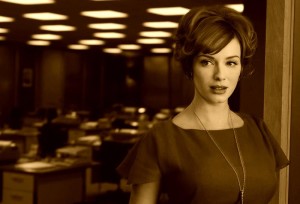 Joan Harris (nee Holloway). Matthew Weiner’s gone on record, explaining he knew exactly how Don Draper’s story would end when he originally pitched Mad Men. By way of contrast, Weiner’s also admitted he hadn’t originally conceived of Joan Holloway as being a recurring character. This is telling, in the same way it’s been telling to see the lack of evolution surrounding Joan throughout the seventh season. The perception of latter-day Joan is that of a beautiful-yet-aging woman who had to sleep her way into a minority share. Whatever comes of her, it won’t amount to much. Maybe Joan stays, maybe she leaves. Maybe she morphs into Ida Blankenship (who also shared a brief affair with Roger Sterling). The most tender thing about Joan is knowing her best assets are behind her. She’s got the money, yet she lacks the ingenuity that sent Peggy into orbit. You’ve gotta wonder what type of impact that might have on her, long-term.
Joan Harris (nee Holloway). Matthew Weiner’s gone on record, explaining he knew exactly how Don Draper’s story would end when he originally pitched Mad Men. By way of contrast, Weiner’s also admitted he hadn’t originally conceived of Joan Holloway as being a recurring character. This is telling, in the same way it’s been telling to see the lack of evolution surrounding Joan throughout the seventh season. The perception of latter-day Joan is that of a beautiful-yet-aging woman who had to sleep her way into a minority share. Whatever comes of her, it won’t amount to much. Maybe Joan stays, maybe she leaves. Maybe she morphs into Ida Blankenship (who also shared a brief affair with Roger Sterling). The most tender thing about Joan is knowing her best assets are behind her. She’s got the money, yet she lacks the ingenuity that sent Peggy into orbit. You’ve gotta wonder what type of impact that might have on her, long-term.
 Betty Francis (nee Draper). There are only two reasons Betty Francis might play a critical role along the stretch. The first has to do with Don’s children, assuming that he leaves for California. The second has to do with what Betty knows regarding Don’s identity. Keep in mind, Henry Francis is an aspiring politician. The higher he rises, the greater the probability someone might dig into his spouse’s past. Is this a reach? It could be. But it’s also the most viable currency in terms of turning up the heat. With Bert Cooper out of the picture, and Jim Cutler slithering into Don’s garden, a reveal of that magnitude could shift the burners on, full-blast. Would disclosure set Don free? Would it send him into exile? In an odd sort of way, Betty Francis holds the key.
Betty Francis (nee Draper). There are only two reasons Betty Francis might play a critical role along the stretch. The first has to do with Don’s children, assuming that he leaves for California. The second has to do with what Betty knows regarding Don’s identity. Keep in mind, Henry Francis is an aspiring politician. The higher he rises, the greater the probability someone might dig into his spouse’s past. Is this a reach? It could be. But it’s also the most viable currency in terms of turning up the heat. With Bert Cooper out of the picture, and Jim Cutler slithering into Don’s garden, a reveal of that magnitude could shift the burners on, full-blast. Would disclosure set Don free? Would it send him into exile? In an odd sort of way, Betty Francis holds the key.
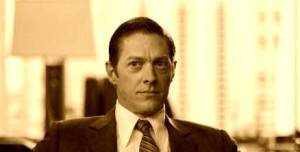 Ted Chaough. Ted Chaough wants out, which is why it’s conceivable Don and Ted might reemerge as partners, in a new venture; one that reinvigorates them in the same way corporate advertising previously did. Barring that, expect Ted to show very little rage against the dying of the light. He’s been there; he’s done that. He wants a break that’s free and clean.
Ted Chaough. Ted Chaough wants out, which is why it’s conceivable Don and Ted might reemerge as partners, in a new venture; one that reinvigorates them in the same way corporate advertising previously did. Barring that, expect Ted to show very little rage against the dying of the light. He’s been there; he’s done that. He wants a break that’s free and clean.
 Bob Benson. Bob Benson was brought in to introduce a point. And that point was that being gay and poor and Podunk in the late 1960s had the same stigma in a business culture as being black or Jewish or Dick Whitman in the fifties. Bob Benson … Don Draper. You do the math. We’ve seen what happens when an executive is unceremoniously outed during the sixties. Perhaps we’ll see how far that culture has evolved during the seventies.
Bob Benson. Bob Benson was brought in to introduce a point. And that point was that being gay and poor and Podunk in the late 1960s had the same stigma in a business culture as being black or Jewish or Dick Whitman in the fifties. Bob Benson … Don Draper. You do the math. We’ve seen what happens when an executive is unceremoniously outed during the sixties. Perhaps we’ll see how far that culture has evolved during the seventies.
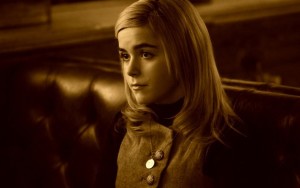 Sally Draper. What viewers saw during “Waterloo” was the early maturation of Sally Draper, equal parts mother and father. Consider a scene in the Francis’ backyard. Sally kisses a boy, disregarding Betty’s one-time rule that, “You don’t kiss boys; boys kiss you.” Note that Sally kisses the pimple-faced nerd, as opposed to an older bohunk who arrives wearing a football jersey (this during an episode where Jim Cutler refers to Don as “a football player in a suit”). Following the kiss Sally remains in the backyard, alone, where she smokes a cigarette, striking the same pose Betty Draper did during Season One. Expect more along these lines throughout the remaining episodes. Sally is her mother. She’s her father. She’s seeking independence or validation from each one.
Sally Draper. What viewers saw during “Waterloo” was the early maturation of Sally Draper, equal parts mother and father. Consider a scene in the Francis’ backyard. Sally kisses a boy, disregarding Betty’s one-time rule that, “You don’t kiss boys; boys kiss you.” Note that Sally kisses the pimple-faced nerd, as opposed to an older bohunk who arrives wearing a football jersey (this during an episode where Jim Cutler refers to Don as “a football player in a suit”). Following the kiss Sally remains in the backyard, alone, where she smokes a cigarette, striking the same pose Betty Draper did during Season One. Expect more along these lines throughout the remaining episodes. Sally is her mother. She’s her father. She’s seeking independence or validation from each one.
Related: “Ranking the Women in Don Draper’s Sex Life (1960-1969)”
(The final seven episodes of Mad Men begin Sunday, April 5th on AMC.)
